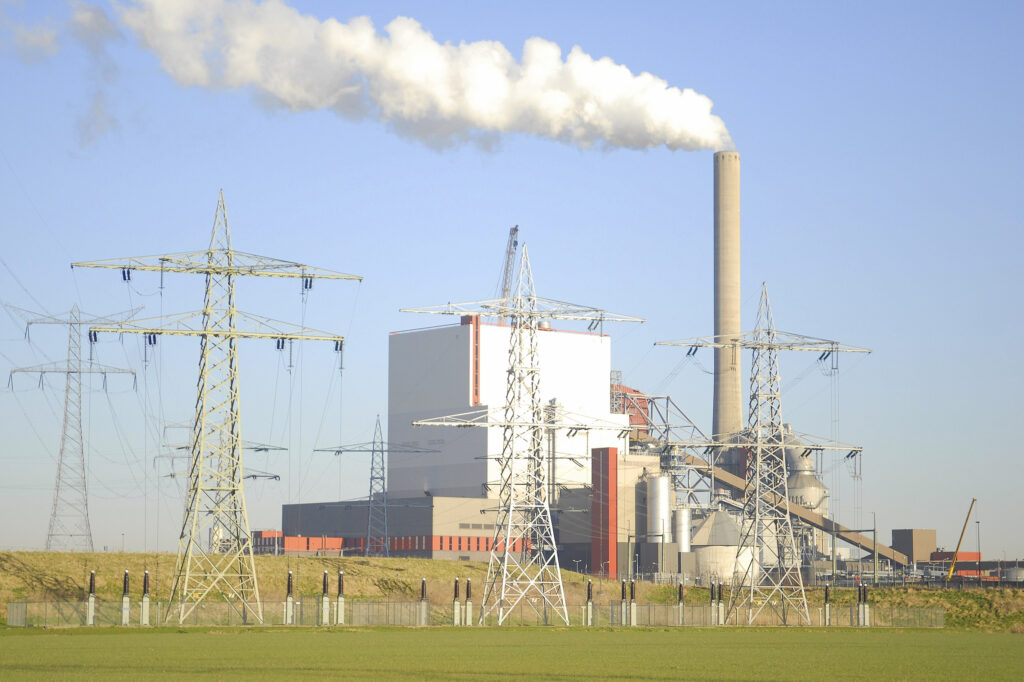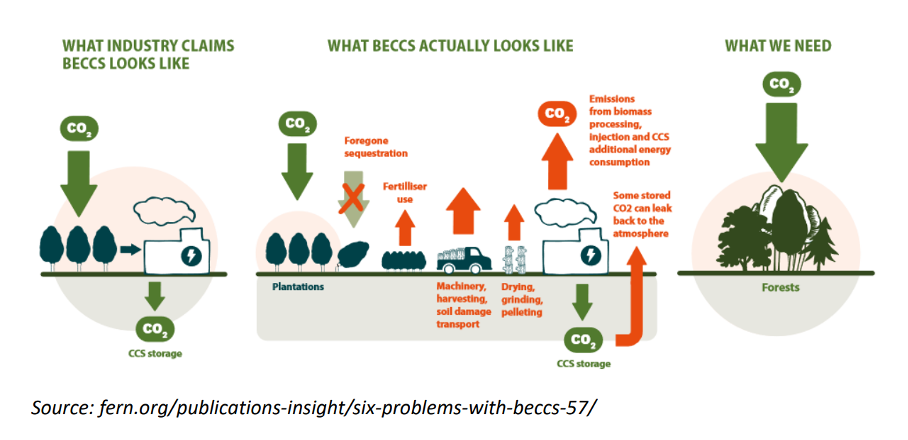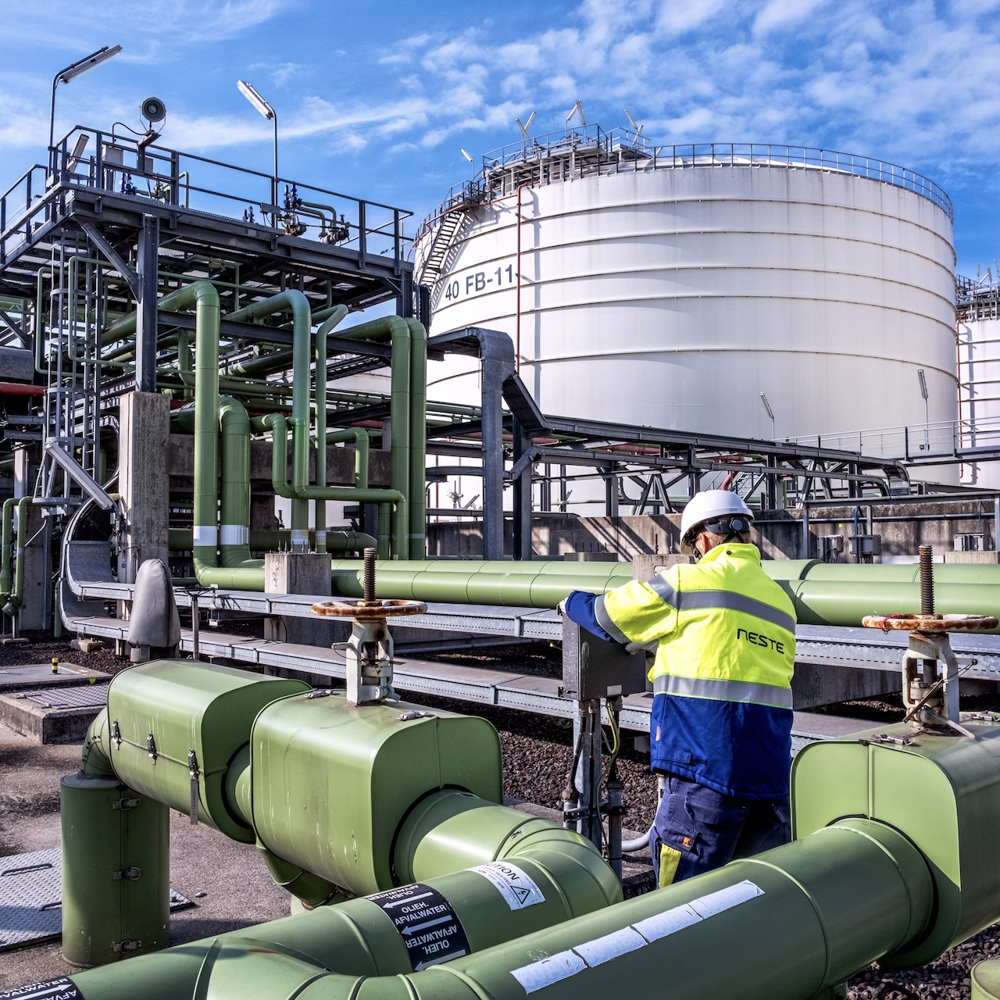The current developments regarding biomass
Dear friends and followers of the Clean Air Committee,
In this newsletter we pay attention to the most important current developments regarding biomass in the last week.
1
RWE, the largest energy company in the Netherlands, has started the procedure to convert its second coal-fired power station Amer to 100% biomass combustion with CO2 capture and storage (BECCS for short). According to Fenna Swart, chairman of the Clean Air Committee, it is incomprehensible that RWE wants to convert the very outdated coal-fired power plant to full biomass combustion with CCS. “RWE indicates that it is ignoring the current mood in society regarding the disastrous effects of biomass and BECCS for climate and biodiversity.” According to CSL, “BECCS is an unproven technique, very expensive and very harmful to forests and biodiversity. Moreover, it is a stupid use of government subsidies. Science has been indicating this for a long time.”
For this reason, the Clean Air Committee, together with foreign forest protection organizations from the US and the Baltic states, has submitted an opinion (LINK) on both initiatives to the authority, the province of Groningen and Noord Brabant respectively. In the opinion they discuss in detail the disastrous effects of RWE’s bad plan for climate, biodiversity and air quality. Read the entire opinion in this newsletter
The following articles with contributions from the Clean Air Committee, in AD, de Volkskrant and NRC, appeared in the press and media last week.
2
The AD published the article last Monday:
Success at the Dubai climate summit threatens to turn into a disaster for forests, according to conservationists. An apparent success at the UN climate summit in Dubai threatens to turn into a disaster for forests and biodiversity, according to conservationists. This concerns the call to triple the amount of renewable energy by 2030. In addition to growth in wind and sun, this probably also means more burning of forests.
Before the start of the climate summit, the new climate commissioner Wopke Hoekstra already received a letter about the subject. Dozens of NGOs called on Hoekstra to exclude biomass from the desired tripling of renewable energy. “It is crucial that the use of forest biomass is phased out as the global energy system transitions to renewable energy sources,” Fenna Swart of the Dutch Clean Air Committee said in the letter. Read the entire article in this newsletter.
3
This was followed by the NRC on Tuesday with the article: Biomass: the pariah of the climate debate. Few potential climate solutions are as controversial as burning biomass. Even nuclear energy has a better name these days. What makes biomass controversial?
According to Fenna Swart, director of the Clean Air Committee, the problem with burning wood is mainly ultrafine dust, the smallest particles. These are very harmful to people, animals and nature. “There are no filters for this in the Netherlands, nor have binding agreements been made about them,” says Swart. “The ministry has been working on a clean air standard for years, in line with EU standards. But this one is still on the drawing board.” Read the entire article in this newsletter.
4
Finally, de Volkskrant paid attention to the European Court of Auditors’ report on biofuels in the article: European Court of Auditors very critical of Brussels policy on biofuels.
The European Court of Auditors leaves hardly a chip on the Brussels policy on biofuels. A long-term perspective is lacking, and despite investments of hundreds of millions of euros, biofuels are not competitive and not always environmentally friendly, the audit office said in a report published on Wednesday. “The report confirms what we have been saying for five years about biofuels in general and biomass in particular,” says chairman Fenna Swart of the Clean Air Committee, which opposes the use of biomass. “The investment in biofuels sounds sustainable, but in reality it is a counterproductive climate measure.” According to Swart, expanding natural forests is the only option to remove more CO2 from the air and achieve the reduction targets.
If you have any questions or suggestions for us or for the campaign, you are very welcome. Also, if you think you can support the team, please let us know.
Finally, the Clean Air Committee is an independent foundation with an ANBI status. We do not receive state funding. Your gifts are greatly appreciated! Thanks to your support we can continue to take action. We are committed to clean air, forests and biodiversity, so that our children can also live on a livable planet.
Do you also think Clean Air and a healthy living environment for people, animals and nature are important? Then you can donate 👉🏼 here. Thank you.
Sincerely,
Maarten Visschers and Fenna Swart 🐳 🌳
PRESS RELEASE | 13 December 2023
RWE starts controversial permit process for biomass with BECCS Amer power plant
From coal to conversion full biomass power plant
RWE, the largest energy company in the Netherlands, has started the procedure to convert its second coal-fired Amer power plant to 100% biomass combustion with CO2 capture and storage (BECCS for short). According to Fenna Swart, chairperson Clean Air Committee, it is incomprehensible that RWE wants to convert the very outdated coal-fired power plant to full biomass combustion with CCS. “With this RWE indicates that it ignores the current mood in society regarding the disastrous effects of biomass and BECCS on climate and biodiversity.” BECCS, according to CSL, is an unproven technology, extremely expensive and very damaging to forests and biodiversity. Moreover, it is a stupid use of government subsidies. Science has been indicating this for a long time’.

Dutch forest cleared in 4 years
Back in October, RWE published a note for the start of the environmental impact assessment of the complete conversion of its Eemshaven (Groningen) coal-fired power plant to BECCS. RWE wants to burn 6 million tons of biomass there annually. To that will now be added the Amer power plant with 2.5 million tons of biomass annually. The woody biomass to be burned is obtained through industrial systematic clearing of forests in the Baltic states, the US and Canada, among others. Burning an annual total of 8.5 million tons in the two RWE coal-fired power plants would clear the entire Dutch forest in just over 4 years.
Increasing biomass co-firing also part of environmental impact report
The current biomass co-firing falls back to the 2011 nature permit due to the cancellation of the current permit. This means that co-firing will fall from 1.2 million tons annually to 0.5 million tons of biomass. The increase in co-firing should therefore also be part of the environmental impact report, according to the Clean Air Committee. However, in the Notitie Reikwijdte en Detailniveau (NRD) on the plan for a BECCS for the Amer power plant, RWE states that this only concerns CO2 capture and storage.
Submission of Views Committee Clean Air ism forest protection organizations
Together with foreign forest protection organizations from the U.S. and the Baltic states, the Clean Air Committee has submitted their views on both initiatives to the competent authorities, the provinces of Groningen and Noord-Brabant, respectively. In the statement they elaborate on the disastrous effects of RWE’s unfortunate plan for climate, biodiversity and air quality.
Contact for press:
Comité Schone Lucht
Ph: +31 (0)6 415 14 330
Context
Scientists indicate that the so-called “climate measure BECCS” actually emits rather than captures CO2 (see also Appendix 3). For example, scientist Dr. Tim Searchinger of Princeton University (USA) reiterated this during the biomass round table discussion on June 15 in the House of Representatives. In BECCS, the energy sector deliberately overlooks some major CO2 emissions. As a result, biomass combustion with CO2 capture and storage is completely wrongly called CO2 negative.
Appendices
1. Viewpoint on NRD for the EIA “BECCUS at Amer power plant”
Viewpoint (link) on the Notitie Reikwijdte en Detailniveau (NRD) for the EIA “BECCUS at the Amer Power Plant”. Clean Air Committee, Dogwood Alliance (USA) and Save Estonia’s Forests. Dd November 27, 2023.
2. Background information BECCS
a. BECCS, a counterproductive climate solution and false promise
https://comiteschonelucht.nl/averechtse-klimaatoplossing-en-valse-belofte-beccs/
BECCS is the burning of biomass for power generation combined with capture and storage of CO2. It is a false promise, disastrous for climate and biodiversity. An attempt by energy companies to continue to fuel their coal and power plants with biomass. This memorandum details the major drawbacks.
b. Statement 87 scientists on BECCS (February 2021)
https://sites.tufts.edu/gdae/files/2021/07/A-Statement-by-Scientists-on-BECCS-FINAL-for-Submission-with-signatures.pdf
c. Coal Ban Act
As of January 1, 2025, the RWE Amer power plant may no longer burn coal. Because the Amer power plant is an old power plant with relatively low efficiency, the coal-fired power plant must close as early as January 1, 2025 (incidentally, the energetic efficiency with biomass combustion is even lower than with coal combustion). This is stipulated in the Law banning coal in electricity production (https://wetten.overheid.nl/BWBR0042905/2022-01-01). Energy company RWE wants to fire the coal-fired power plant on biomass after stopping coal combustion. The CO2 released in the process, the company wants to store it underground or reuse it.
3. Schematic representation of CO2 emissions at BECCS

Bron: https://www.fern.org/fileadmin/uploads/fern/Documents/2022/Six_problems_with_BECCS_-_2022.pdf
NRC | 11 December 2023
Biomass: the pariah of the climate debate
Few potential climate solutions are as controversial as burning biomass. Even nuclear energy has a better name these days. What makes biomass controversial?

The earth works like a cycle, everything returns at some point. Even fossil fuels such as coal, oil and gas. But that takes millions of years. Humanity cannot wait for that in its insatiable need for energy. This is different for wood. For every tree you cut down, you can plant a new one. And although wood emits 16 percent more CO2 per unit of energy produced than coal and even 94 percent more than gas, wood burns well. So renewable.
That is why it is such an attractive idea to use biomass, such as wood, in power plants. So attractive, in fact, that biomass plays an important role in the sustainable energy mix of the European Union. According to the European Environment Agency, of all energy that the EU calls sustainable, 41 percent came from solid biomass last year, about the same as in the Netherlands, according to CBS figures.
The EU even offers billions in subsidies for this. A strict certification system must ensure that the money goes to the right place and does not contribute to, for example, illegal logging and the disappearance of biodiversity in natural forests. There are few energy sources where proponents and opponents are so diametrically opposed to each other. Even nuclear energy is less controversial these days. At the almost recent climate summit in Dubai, there were positive voices about nuclear energy, but it was noticeably silent about biomass, apart from a few ‘side events’ and an urgent letter to European Commissioner Wopke Hoekstra, the EU’s chief negotiator in Dubai. The letter warns against “over-reliance on biomass energy, at the expense of forests, biodiversity and essential carbon storage.”
Supporters don’t understand it
Why the fear? Supporters don’t understand it. The calculation is clear. “Biomass first removes CO2 from the air via photosynthesis, and that CO2 is released again when burned,” Martin Junginger explains in an email. He is professor of Biobased Economy at Utrecht University and an advocate of energy from biomass. “If you also ensure that the biomass, the tree, is replanted, no net carbon is added to the atmosphere. This is the case with fossil fuels.”
This is a reality on paper, says Louise Vet, former director of the Netherlands Institute of Ecology and emeritus professor of evolutionary ecology at Wageningen University & Research. She has been fulminating against the use of energy from biomass for years. According to her, the idea that for every felled tree a new one is planted that removes the released CO2 from the air ignores a fundamental problem: the “loss of time”. Scientists at MIT, the technological university in Massachusetts, have calculated that it takes 44 to 104 years for new plantings to absorb all the CO2 released from the atmosphere during combustion. And that doesn’t even take into account the extra CO2 that the now burned tree would have absorbed if it had not been cut down.
Junginger does not deny a ‘waste of time’. But according to him, it doesn’t have to be that complicated. How does he solve the problem of a tree that takes thirty years to store its carbon and is burned all at once? “In this example you cut down one tree, and then wait thirty years,” Junginger writes. “But a biomass power plant needs a continuous supply. And so you usually have thirty trees in the landscape – or better: thirty plots of forest – of which you harvest one plot every year. You let the 29 other plots grow quietly. They capture CO2 and thus compensate for the emissions from the combustion of that one plot.”
Moreover, advocates say, trees eventually die and release the stored carbon into the atmosphere as CO2. The same applies to pruning waste. If you leave it, it will rot and release CO2. Then you might as well stoke it.
Own rules of the game
But according to the opponents, nature has its own rules. “When burned, all CO2 immediately goes into the air,” says Louise Vet. “Wood that decays only emits a quarter to a third of its CO2 in ten years.” And a large part of the carbon in natural forests is absorbed by the soil. “That is an important source of nutrients and indispensable for the growth of the forest and therefore the capture of new CO2. Forests do not produce waste. Forests are the textbook example of a circular economy.” So it is better not to intervene, is the conclusion.
Junginger questions this. It is true, he says, that rotting is indeed not as rapid as combustion. But in the Netherlands, a thick branch is already 45 percent rotten after five years, while thinner branches are half rotten after less than two years. According to Junginger, other frequently heard criticism of the use of biomass is also unfounded: the fear of particulate matter. “That is a problem with fireplaces and wood stoves. Open fireplaces in particular are a significant source of particulate matter in the Netherlands. As far as I’m concerned, they should be banned immediately. Large-scale biomass power plants have extremely efficient filters, which means emissions are minimal. The biomass power plant in Utrecht, where I live, supplies 40 percent of the district heat. But the contribution to the total particulate matter load in the area is less than 0.1 percent. To reduce particulate matter emissions, it is better to drive 80 km on the A2 than to stop burning biomass in a power plant.”
According to Fenna Swart, director of the Clean Air Committee, the problem with burning wood is mainly ultrafine dust, the smallest particles. These are very harmful to people, animals and nature. “There are no filters for this in the Netherlands, nor have binding agreements been made about them,” says Swart. “The ministry has been working on a clean air standard for years, in line with EU standards. But this one is still on the drawing board.”
Junginger thinks that biofuels will remain necessary in the coming decades. Especially in economic sectors that are difficult to electrify – such as high-temperature heat in industry, and biofuels in aviation and shipping.
Junginger also considers sun and wind as a better and, above all, cheaper alternative for ‘normal’ electricity generation. But during what the Germans so beautifully call a Dunkelflaute, when the sun doesn’t shine and the wind doesn’t blow, a biomass power plant offers a necessary and, in Junginger’s eyes, sustainable backup. As long as it is necessary, it is really better to continue using gas, Swart believes. This will serve biodiversity and climate better. And the wind is actually always blowing at sea.
Source: https://www.nrc.nl/nieuws/2023/12/11/biomassa-de-paria-van-het-klimaatdebat-a4183920
ALGEMEEN DAGBLAD | 10 December 2023
Success at the Dubai climate summit threatens to turn into a disaster for forests, according to conservationists
An apparent success at the UN climate summit in Dubai threatens to turn into a disaster for forests and biodiversity, according to conservationists. This concerns the call to triple the amount of renewable energy by 2030. In addition to growth in wind and sun, this probably also means more burning of forests.

“This is a very dangerous development,” warns Peg Putt of the Global Forest Coalition at the climate conference. She welcomes more renewable energy, but not in the form of wood pellets. “Biomass is not climate neutral, and cutting down forests actually reduces the capacity to absorb CO2. Large-scale combustion of biomass should therefore be excluded from the goal of tripling renewable energy,” says the Australian activist in Dubai.
800 year old tree
She receives support from concerned forest protectors in Indonesia and from dozens of international NGOs, including the Dutch Clean Air Committee. “You can’t tell us that burning an 800-year-old tree will produce sustainable electricity,” said David Tong, campaign director for Oil Change International. “The burning of forests should not be accepted as renewable energy.”
More than 120 countries have already supported the call in Dubai to generate 11,000 gigawatts of renewable energy by 2030. This makes this European Union initiative a success and the tripling will probably be included in the final text of the summit. More renewable energy is necessary to achieve that other major ambition: an end to, or at least a phasing out of, fossil fuels such as oil and gas.
But exchanging fossil fuels en masse for biomass combustion, especially on the scale at which energy continues to be needed, would be a disaster for the planet, the NGOs say. The International Energy Agency (IEA) already expects explosive growth in the demand for bioenergy in the coming decades. It currently accounts for 6 percent of our total energy consumption and will increase to 13 percent in 2030 and to 18 percent in 2050, according to the EIA. “These numbers are horrendous,” says Putt. “That much woody biomass cannot possibly be sustainable.”
We expect that the new co-firing will soon require forests and plantations in Sumatra, Kalimantan and Papua.
—Beyrra Triasdian, Trendasia
Indonesia is one of the Asian countries that is now turning to the use of biomass. Although coal-fired power stations should actually be phased out slowly, the Indonesian government wants to make them ‘sustainable’ by mixing wood pellets up to 5 to 10 percent in addition to coal. For the time being this concerns 57 coal-fired power stations, but possibly more than a hundred in which trees are additionally fueled.
“This is not the right solution,” said Beyrra Triasdian, an Indonesian researcher from the Trendasia organization. “We expect that the new co-firing will mainly require forests and plantations in Sumatra, Kalimantan and Papua. In total, this amounts to an area of 2.3 million hectares of forest that is needed.” This concerns an area the size of more than half of the Netherlands.
Triasdian: “And then we are not even talking about exports. Because countries such as Japan and South Korea are also looking for biomass for their power stations.” The renewable energy researcher fears for her country’s biodiversity if natural forests are converted into wood pellet monocultures. “In addition, it is a threat to indigenous groups of people who live in the forests and make their living from those forests,” says the Indonesian. Before the start of the climate summit, the new climate commissioner Wopke Hoekstra already received a letter about the subject. Dozens of NGOs called on Hoekstra to exclude biomass from the desired tripling of renewable energy. “It is crucial that the use of forest biomass is phased out as the global energy system transitions to renewable energy sources,” Fenna Swart of the Dutch Clean Air Committee said in the letter.
‘Not in mandate’
Hoekstra hardly seems to be involved with biomass in Dubai for the time being. A source at the European negotiating delegation states that biomass is not a topic of discussion during the talks with other countries. The subject is ‘not in the mandate’ with which the European Commissioner was sent to Dubai. Hoekstra’s predecessor, GroenLinks-PvdA leader Frans Timmermans, as European Commissioner ensured that biomass in the EU is still classified as ‘sustainable’.
In the Netherlands, Minister Rob Jetten (Climate) has restricted the use of biomass since 2022 and no longer provides subsidies for new biomass projects. Nevertheless, energy company RWE now wants to completely convert its two coal-fired power stations in Geertruidenberg and Eemshaven to biomass. The first permits for this have been applied for. The company wants to capture the CO2 and put it underground.
de Volkskrant | 13 December 2023
European Court of Auditors very critical of Brussels policy on biofuels
The European Court of Auditors leaves hardly a chip on the Brussels policy on biofuels. A long-term perspective is lacking, and despite investments of hundreds of millions of euros, biofuels are not competitive and not always environmentally friendly, the audit office said in a report published on Wednesday.

These conclusions are bad news for the European Commission. The use of biofuels is an important pillar of Brussels’ climate policy. Biofuels are seen as an alternative to fossil fuels. They should help reduce CO2 emissions from the transport sector.
Over the past ten years, approximately 430 million euros have been spent on research projects to promote the use of biofuels. But so far little has come of this use, partly because it takes a long time for biofuels to reach the pump from the lab. An average of one to two decades, according to audit member Nikolaos Milionis.
Because policy has repeatedly changed in recent years, investors have become shy. Milionis says that the EU is not following a clear course and is therefore in danger of missing its goals.
The report cites aviation as an example, which is difficult to electrify and will therefore rely heavily on biofuel to become greener. For this reason, a law was passed this year stating that 6 percent of aviation fuel must be sustainable by 2030.
Road map missing
“Europe has set ambitious goals, but the production capacity for sustainable kerosene is very limited,” Milionis said on Wednesday while explaining the European Court of Auditors’ report. Today’s factories can barely produce a tenth of the amount of fuel needed by then. There is no so-called roadmap to increase capacity.
The future for biofuels in road traffic is also shrouded in mystery, the researchers say. After 2035, all new cars must be electric or run on CO2-neutral fuel – a term that, according to Milionis, has no legal status. The Court of Audit warns that after 2035 there will still be millions of cars driving around that require liquid fuel. There are no plans for this.
In addition to production problems, high costs are also a challenge and the environmental benefits of biofuels are often overestimated. The European Commission expects that the use of biofuel can increase energy independence, but in reality it is growing.
Cooking oil
This is evident from the growing import of cooking oil (a basic ingredient for sustainable diesel and kerosene, among other things) from countries such as China, Indonesia, Malaysia and even the United Kingdom. In addition, biofuels compete with other sectors for raw materials. Finally, organic is more expensive than fossil. Green kerosene, for example, costs up to six times the price of regular kerosene.
In addition, CO2 emission allowances are currently cheaper than the costs of reducing emissions through the use of biofuel. This makes it ‘payable’ to continue using fossil fuels. Biofuels are therefore not economically viable for the time being, according to the Court of Audit.
Expansion of forests
“The report confirms what we have been saying for five years about biofuels in general and biomass in particular,” says chairwoman Fenna Swart of the Clean Air Committee, which opposes the use of biomass. “The investment in biofuels sounds sustainable, but in reality it is a counterproductive climate measure.” According to Swart, expanding natural forests is the only option to remove more CO2 from the air and achieve the reduction targets.
Wednesday’s report is the umpteenth in a recent series in which the European Court of Auditors casts strict judgments on European policy. Last spring, the calculators concluded that the European ambitions to reach the world top in the field of battery production are virtually unattainable. A short time later, they warned that the EU is unlikely to meet its 2030 climate and energy targets.
The Clean Air Committee Foundation has ANBI status

Your gift is greatly appreciated! Thanks to donations we can take action. We are committed to clean air, forests and biodiversity, so that our children can also live on a livable earth. Do you also think Clean Air and a healthy living environment for people, animals and nature are important? Then you can donate here.
The Clean Air Committee Foundation has been designated as an ANBI by the Tax Authorities. The ANBI status has been granted with effect from January 1, 2023. You can verify our ANBI status on this page of the Tax Authorities. You then enter ‘Stichting Comité Schone Lucht’ in the top field and press the ‘Toon resultaten’ button. Then you will see our Foundation emerging.
Tax number or RSIN of Committee Clean Air: 860550783. This means that the Committee Clean Air Foundation does not have to pay gift and/or inheritance tax on the donations and inheritances received. In addition, donations to our Foundation are deductible. You can calculate your tax benefit with a simple tool here. Further information such as statutes and policy plan can be found here.

Join us.
All expertise is welcome.
Send an email or follow us for the latest developments:
